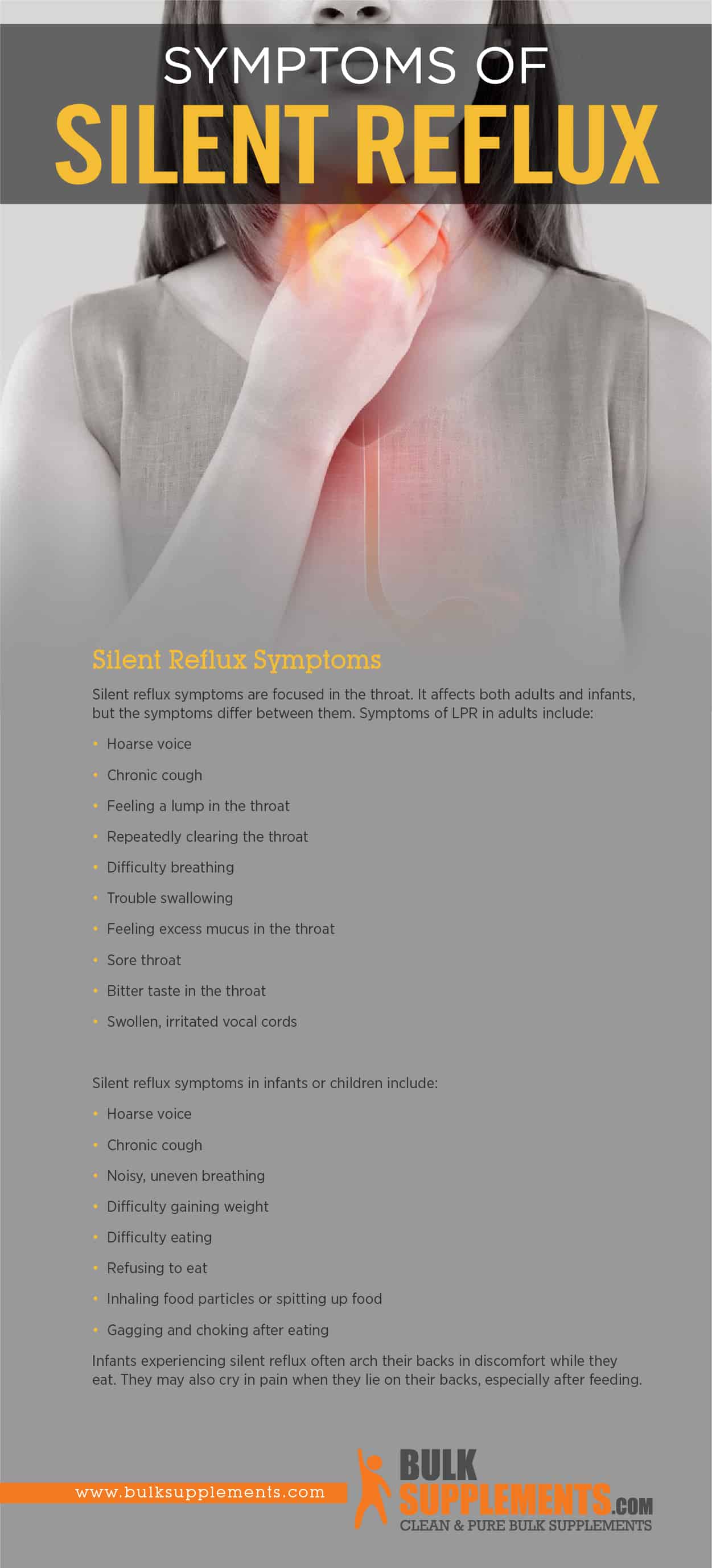Silent Reflux: Causes, Symptoms & Treatment
by James Denlinger Digital Marketing StrategistWhat is Silent Reflux?
Laryngopharyngeal reflux (LPR) is a condition that causes stomach acid to flow back up into the throat. It is also known as “silent reflux” because it does not cause typical acid reflux symptoms, such as heartburn. But it can cause damage to the throat and vocal cords. Stomach acid is made up of water, enzymes, hydrochloric acid, mucus, electrolytes and intrinsic factor. These substances cause irritation, burning and discomfort in the throat when the acid meets the food pipe and vocal cords.
LPR is a manifestation of gastroesophageal reflux disease (GERD), which is characterized by chest pain from reflux flowing from the stomach to the esophagus. But LPR causes reflux in the throat and vocal cords specifically. Some people experience both LPR and GERD together, but LPR usually does not cause heartburn related to GERD.
Silent Reflux Symptoms
Silent reflux symptoms are focused in the throat. It affects both adults and infants, but the symptoms differ between them. Symptoms of LPR in adults include:
- Hoarse voice
- Chronic cough
- Feeling a lump in the throat
- Repeatedly clearing the throat
- Difficulty breathing
- Trouble swallowing
- Feeling excess mucus in the throat
- Sore throat
- Bitter taste in the throat
- Swollen, irritated vocal cords
Silent reflux symptoms in infants or children include:
- Hoarse voice
- Chronic cough
- Noisy, uneven breathing
- Difficulty gaining weight
- Difficulty eating
- Refusing to eat
- Inhaling food particles or spitting up food
- Gagging and choking after eating
Infants experiencing silent reflux often arch their backs in discomfort while they eat. They may also cry in pain when they lie on their backs, especially after feeding.
 PIN IT
PIN ITCauses of Silent Reflux
Silent reflux results from physical complications and lifestyle factors. For example, it can be a result of a faulty sphincter, which is a muscle that separates the stomach and the esophagus. The primary function of the sphincter is to keep stomach contents where they should be — in the stomach — by staying closed except when you are swallowing food. But in silent reflux, the sphincter does not close, forcing stomach contents back up into the throat and voice box. It can also result from a hiatal hernia, from esophageal spasms or if the stomach empties slowly.
Children may develop silent reflux for the same reasons as adults, or it may be a result of growth or developmental issues. Infants commonly experience reflux because their food is mostly liquid, they are lying down most of the time and the sphincter is less developed than an adult.
Risk Factors for Silent Reflux
Silent reflux affects people of all ages. However, it is more likely to affect people who overeat, smoke or frequently drink alcohol and soda and eat spicy and fatty food. Other risk factors include weight, stress and tight clothing. Research also considers gender as a factor. One study discovered that males experienced silent reflux more often than women.
Complications of Silent Reflux
Although it’s rare, silent reflux can cause stomach acids to accumulate in the throat and larynx, which may lead to long-term damage and complications if it is not treated.
Children can experience breathing problems, esophagitis, esophageal bleeding and difficulty swallowing from scar tissue in the esophagus. Adults can develop lung disorders, chronic cough and oral cavity disorders. They can also experience recurrent pneumonia and laryngitis. Reflux also increases the risk of esophageal cancer.
Silent Reflux Diagnosis
To diagnose silent reflux, doctors perform a physical exam and examine the patient’s medical history. They also run tests including pH monitoring or an endoscopy. In an endoscopic exam, doctors attach a small camera to a tube and pass it through the mouth to view the vocal cords and throat. A pH monitor records the pH in the esophagus for 24 hours.
Silent Reflux Treatment
To treat silent reflux, doctors may recommend lifestyle changes, medications or surgery, in rare cases.
Medication
Doctors may prescribe medications to treat silent reflux symptoms, such as antacids, proton pump inhibitors and H2 blockers. Antacids keep stomach acid from the throat, while proton pump inhibitors reduce acidity in the stomach. H2 blockers are a form of antihistamine that can reduce coughing.
Lifestyle Changes
Lifestyle changes include maintaining a healthy weight and avoiding smoking, alcohol and tight clothing. Patients should also eat slowly and eat smaller, more frequent meals throughout the day. It is healthier to eat three to four small meals instead of two to three large ones. Certain products may also trigger the condition, such as mint, chocolate, caffeine, red wine, carbonated drinks and spicy foods. Avoiding these products may prevent and relieve silent reflux symptoms. Doctors also advise against eating too close to bedtime and recommend meals at least three hours before going to bed. Chewing gum can also be an effective treatment because it stimulates saliva secretion and neutralizes acids. Managing stress and anxiety can also help manage and prevent the condition.
Surgery
Although some patients respond well to medication and lifestyle modifications, others may require surgery. The surgical treatment for silent reflux is fundoplication, which tightens the sphincter — the muscle separating the esophagus and the stomach. Research concludes that fundoplication is an effective treatment for most symptoms of silent reflux.
Treatment for Infants and Children
To manage silent reflux in children, parents should feed their babies small amounts of food more frequently and keep them upright for at least half an hour after they eat. Doctors also suggest thickening formula or breast milk with a tablespoon of oat cereal. It’s important for parents to remember that although some cases need medication or surgery for treatment, most cases of silent reflux will resolve on their own.
Supplements for Silent Reflux
Fennel Powder
This is an excellent antioxidant that supports digestive and urinary tract health. The recommended intake amount for fennel powder is 1,000 mg up to two times per day.
Aloe Vera Extract Powder
From the aloe vera plant, this product promotes skin health, immune health and can help minimize symptoms of silent reflux. The recommended safe serving size is 1,000 mg once per day with water.
Licorice Root Extract Powder
Originating from the Mediterranean, licorice root promotes digestion and relieves cough and headache. It is also known for its immune boosting properties. The healthy serving size for this supplement is 600 mg per day.
Chamomile Extract Powder
This is an excellent supplement for people with silent reflux because it supports digestive health. Chamomile also helps to ease anxiety and inflammation. The recommended serving size is 800 mg once or twice per day with water.
Melatonin Powder
This product is an excellent antioxidant with anti-inflammatory properties. Melatonin is a natural sleep aid used to help manage insomnia, which makes it an excellent choice for people who struggle to sleep as a result of silent reflux. In also supports digestive and cardiac health. The suggested intake is 1 to 3 mg, only before bedtime. Melatonin is potent, so do not exceed the recommended dosage and avoid driving after taking it.
Magnesium Citrate Powder
This supplement is known for its energy-boosting properties and its effects on bone, cardiac and digestive health. It is a mild laxative that may help minimize abdominal discomfort. The safe serving size for magnesium citrate powder is between 1,662 and 3,325 mg daily, mixed with a drink. For the best results, take it with calcium in a 1:2 ratio.
L-Glutamine Powder
With energy-boosting properties that promote athletic endurance, L-glutamine also supports cardiac and digestive health. The healthy serving size for L-Glutamine is 1,000 mg up to three times per day, either an hour before a meal or three hours after.
The Bottom Line
Laryngopharyngeal reflux, commonly known as silent reflux, causes stomach acid to flow back up into the throat. It causes discomfort, irritation and burning in the throat.
Common symptoms of silent reflux in adults include difficulty swallowing, chronic cough, hoarseness and feeling a lump or excess mucus in the throat. Children and infants have trouble eating and gaining weight and gag or choke after meals. They may also refuse to eat and cry when they lie on their backs. Fortunately, silent reflux is preventable and treatable with certain lifestyle changes, antibiotics or surgery in rare cases.
Sponsor Ads
Created on Mar 18th 2020 17:06. Viewed 307 times.




